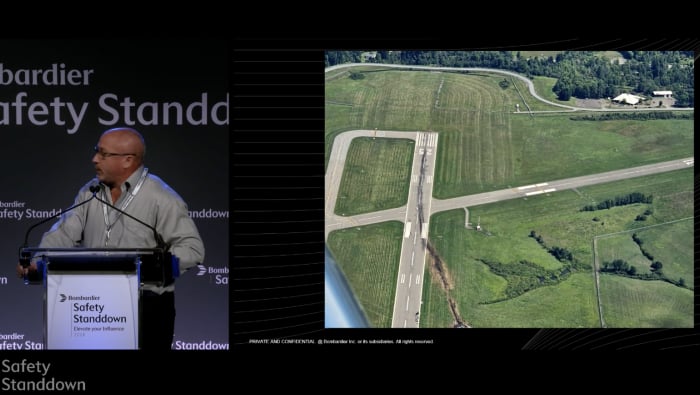|
Contract pilot Kevin Van Splunder took the stage this week at Bombardier Safety Standdown to share his experience during an extremely hard emergency landing and subsequent fire in a Citation X+ on August 5 in Jamestown, New York. Details about what caused the failures in the airplane aren’t yet available, but Van Splunder shared an image of the flight track of the airplane during its short seven-minute flight. “I've learned, I've applied—and you'll understand why—and now I'm here to share it,” he told the audience. Climbing through 5,000 feet, he smelled smoke and pointed that out to the captain, who said he didn’t smell the smoke. But Van Splunder commented, “Well, that’s interesting, maybe we should do something.” At 10,000 feet, the jet began to level off and accelerate and then it started descending, uncommanded. “All of a sudden, we saw ourselves in a descent at 494 knots and 6,700 feet per minute. It's about 73 seconds to impact.” The Citation hit the ground 200 feet before the runway threshold and bounced into the air, then onto the runway before sliding onto the grass, bouncing back into the air and spinning around, and finally coming to a stop in a total of just 2,020 feet. Then the aircraft caught on fire. |
|
|
Fund manager Elliott Investment Management wants Honeywell broken up, with the group’s aerospace division established as a separate business. Yesterday, Elliott wrote to the board of Honeywell International calling for “a simplification of Honeywell’s conglomerate structure” in a move that it said would boost the share price over the next two years by between 51% and 75%. “Uneven execution, inconsistent financial results, and an underperforming share price have diminished the company’s strong record of value creation over the last five years,” Elliott argued. It pointed out that the funds it manages have invested more than $5 billion in the industrial group, which is active in many sectors beyond aerospace and defense. While acknowledging Elliott’s comments, Honeywell International gave little indication that it intends to embrace the proposed change. “Honeywell’s board of directors and management acknowledge and appreciate the perspectives of all our shareholders,” the group said in a written response. “Although Elliott had not made us aware of their views prior to today, we look forward to engaging with the firm to obtain their input. Our leadership welcomes investor feedback as we continue to execute a disciplined strategy, which includes pursuing sustainable growth, optimizing the portfolio, and maintaining an accretive capital deployment program.” Elliott’s letter to the Honeywell board provides a detailed analysis of what it regards as shortcomings in the group’s performance and structure. |
|
|
Don Dwyer, the co-managing partner at preowned business aircraft broker Guardian Jet, expressed optimism for the industry this week at the Corporate Jet Investor Miami conference. “I think the market came back really strong. We saw inventories grow; they’re now sliding down a little. I think there’s an underlying optimism in the people who are buying and selling airplanes long before the outcome of the election,” he said. “We felt like it was great, it was our greatest year ever. We’re happy as a clam.” Asked if they thought potential U.S. tariffs would impact the industry in the future, panelists were cautious to answer. “I think if we get into a tariff war, it’s a tit-for-tat situation,” said Rollie Vincent of JetNet IQ. “If prices go up, Main Street won’t be happy about that.” Notably, Alan Walsh of Sentient Jet has seen an uptick in demand since the election concluded. “It is nuts,” he said. “There is seasonality associated, but yeah, there’s been a big uptick in bookings even in the last six days.” “Without being political, I will tell you that on Wednesday my wife was apoplectic until around noon and I asked if she looked in her Merrill account,” added Dwyer. “I think that was a microcosm of what was going on around the country. It’s nice there was a decisive victory and the markets responded.” |
|
|
Gulfstream Aerospace’s ultra-long-range G700 flagship continues to amass city-pair records, with the tally now topping 65. Most recent record flights included a 4,090-nm journey from Savannah, Georgia, to Honolulu in 8 hours 52 minutes using a blend of sustainable aviation fuel and averaging a speed of Mach 0.90. The aircraft also flew 6,507 nm from Los Angeles to Sydney in 14 hours and 26 minutes. These records are pending formal recognition from the U.S. National Aeronautic Association and Fédération Aéronautique Internationale in Switzerland. Records continue to accrue as Gulfstream shows off its newest certified model globally. “Gulfstream continues to see remarkable interest in the G700 around the world, and we are pleased to take it directly to our customers to showcase the capabilities this aircraft has to offer,” said Gulfstream president Mark Burns. Meanwhile, the G700 is appearing this week at the Bahrain International Airshow, where it is being displayed alongside the venerable G500 until Friday. “Gulfstream continues to see strong demand in the Middle East and interest in our next-generation fleet remains high,” said Scott Neal, senior v-p of worldwide sales for Gulfstream. “The G700 and G500 each provide a combination of advanced technology, cabin comfort, and performance capabilities that continue to resonate with operators in the region.” Since U.S. FAA certification in March, the 7,750-nm twinjet has received validations from EASA and nine other nations. |
|
|
Tony Kern, for 28 years the influential speaker on the first day of Bombardier Safety Standdown and founding partner and CEO of Convergent Performance, challenged the audience yesterday at the opening of the 2024 edition of Standdown. “As you listen to me, as you listen to all the other speakers, I want you to think about reversing this theme a little bit, and ask yourself, what influences you? Who influences you?” Tying together the influence theme and how business aviation professionals can help each other with safety issues related to preparedness, Kern illustrated his points with Venn diagrams showing the intersection between unexpected events and lack of vigilance, complacency, and apathy. “What if we could influence ourselves? What if we could influence others and replace that apathy and complacency? No one is apathetic or complacent overall; it goes up and down. Sometimes we're apathetic, sometimes we're bored, sometimes we're complacent, and other times we're hypervigilant.” What Kern was trying to point out is that bolstering vigilance can help prevent accidents or prepare pilots to handle the unexpected. “I want to think about…moving that spectrum a little bit and recognizing when we begin to drift. Now we get that unexpected event, but it's not so unexpected. [Shift] to we’ve touched the switches [with our eyes closed], we know where the [emergency] door handle is, and we can keep [accidents or issues] at bay.” |
|
|
Leaders in the business aircraft engine space repeated some themes of optimism that have been heard throughout CJI Miami this week, while others were nervous about celebrating too quickly. “Supply chain is affecting a lot of things right now. Post-Covid, we’re seeing a lot of critical parts that aren’t available right now. We are seeing a little bit of freedom in 2024,” said Honeywell sales manager Zach Ungerleider. “Has it normalized? Not really just yet. But we’re hoping that things are getting a little better, in my opinion.” Richard Berkemeier, senior appraiser at Pegasus Aircraft Appraisal Group, was cautious to join in on that thought. “If we take Trump at his word, maybe he ends the war in Ukraine and suddenly there’s an availability of a lot of engines that have to go into the shop,” he said. “I’m not as optimistic as Zach.” “For the Rolls-Royce experience, it is normalized,” said Rolls-Royce v-p of customer service James Prater. “We have seen supply issues, but we’ve been able to mitigate them. We don’t have people waiting on these engines. In our market segment, we’re robust.” |
|
|
F&E Aircraft Maintenance (FEAM Aero) has agreed to provide support for SkyDrive’s three-seat SD-05 eVTOL aircraft. The Japanese start-up announced the partnership with the independent maintenance, repair, and overhaul group on Wednesday as part of its preparations to start delivering the all-electric model in 2026 to prospective customers in the U.S., Japan, South Korea, and Vietnam. Miami-based FEAM has a network of 52 line stations in the U.S. and Europe, supporting airlines and private aircraft operators. Most of its work is focused on supporting Airbus and Boeing narrow- and widebodies, as well as several regional airliner types. In the U.S., SkyDrive has agreements with private charter flight operator Bravo Air, which intends to operate up to five of the SD-05s from its base at Augusta Regional Airport in Georgia. The manufacturer also has a provisional sales agreement with South Carolina-based charter operator Austin Aviation. According to SkyDrive CEO Tomohiro Fukuzawa, the partnership with FEAM Aero will support its plans to launch commercial operations in the southeastern U.S., and later at regional airports across the country. The SD-05 is intended for short flights of up to 10 miles. “This partnership marks another significant milestone for FEAM Aero as we continue expanding our role in the rapidly evolving advanced air mobility industry—a field we believe will be revolutionized by eVTOL technology,” said FEAM president Cam Murphy. |
|
|
|
|
|
|
AINalerts News Tips/Feedback: News tips may be sent anonymously, but feedback must include name and contact info (we will withhold name on request). We reserve the right to edit correspondence for length, clarity, and grammar. Send feedback or news tips to AINalerts editor Chad Trautvetter. |
|
AINalerts is a publication of AIN Media Group, 214 Franklin Avenue, Midland Park, New Jersey. Copyright 2024. All rights reserved. Reproduction in whole or in part without permission is strictly prohibited. |















